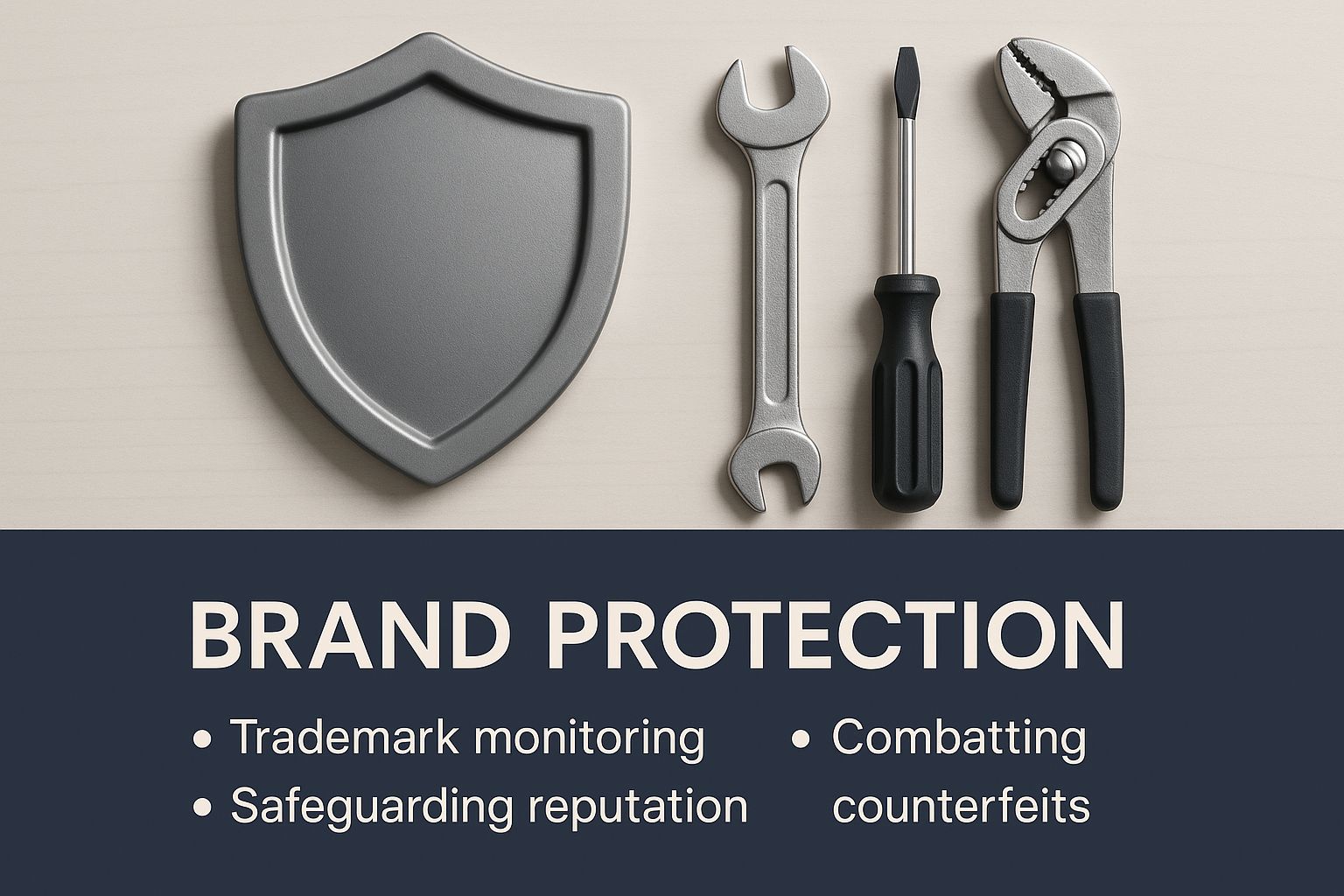Demystifying What Is a Servicemark
Let's be honest, the world of servicemarks can be a bit confusing. Even as an attorney, I sometimes find myself scratching my head. Clarity is essential in legal matters, so let's break down what a servicemark actually is. Simply put, a servicemark is like a trademark, but for services instead of products. Think of it this way: a trademark protects your innovative new beverage, while a servicemark protects your pet-sitting business. One is a tangible thing, the other an intangible action.
Why Does This Matter?
I understand legal topics can sometimes feel dry, but servicemarks are genuinely important, especially for entrepreneurs building service-based businesses. They are crucial for protecting your brand identity and preventing copycats from capitalizing on your hard work and reputation. A strong servicemark can be a powerful asset in today's competitive market.
Servicemarks in the Wild
Servicemarks identify the source of a service, acting like a fingerprint for your business. Consider your favorite ride-sharing app – that recognizable logo is a servicemark, telling you exactly who is providing the ride. Similarly, the name and logo of your preferred streaming service function as a servicemark. These marks are protected under the Lanham Act, just like trademarks, and can be registered with the USPTO. When you see the ℠ symbol, it signifies a servicemark that's "in training." After federal registration, it graduates to the ® symbol.
To further enhance your brand protection, consider developing a comprehensive branding strategy.
Seriously, Why Should You Care?
Many people, including business owners, confuse trademarks and servicemarks. This seemingly small oversight can have significant consequences, including lost revenue, costly rebranding efforts, and legal battles. I once had a client who learned this lesson the hard way. They had a fantastic logo and a catchy slogan but neglected to protect their core service. Competitors quickly moved in, and the client faced significant losses in market share and brand dilution, all because of this one crucial detail. Navigating the complexities of the legal system can be challenging, but securing your servicemark is a crucial step in protecting your business.

Servicemark vs. Trademark: What's Actually Different?

This infographic summarizes brand protection, using a shield icon alongside service-related imagery. It highlights how servicemarks, much like trademarks, are vital for protecting your brand identity. After all, you want to ensure your hard work benefits you, not someone else.
Many people confuse trademarks and servicemarks. Even some lawyers do (don't tell them I said that!). At Cordero Law, we strive for clarity. Both offer vital brand protection, but they cover distinct areas: different types of offerings. Trademarks are for tangible goods—physical items you can hold. Think new sneakers, your phone, or that artisanal coffee. Servicemarks, however, cover intangible offerings: services. Think legal services (like what we do at Cordero Law), your barber, your dog walker, or your accountant.
So, What's the Big Deal? Why Should I Care?
The legal protections are almost identical on paper. But in practice, enforcement and application can be drastically different. (And if you think paperwork is unimportant, you haven't dealt with the USPTO.) This is where many people stumble. They think, "I sell t-shirts, so I need a trademark." But what if you also offer custom design services? That's servicemark territory. Many of my clients, particularly young entrepreneurs, offer both products and services. This complicates things quickly. You might be interested in: How to master…
Let’s Talk Actual Differences.
Here’s a breakdown of the key differences between servicemarks and trademarks:
Subject Matter: Trademarks protect goods (physical items). Servicemarks protect services (actions, activities). Think of it like the difference between nouns and verbs.
Use in Commerce: Both require "use in commerce," meaning you're actively using the mark to sell goods or services. This isn't theoretical; it's real-world application.
Application Process: Both are filed with the USPTO, but the specifics, such as the required specimens, can vary. You might submit a product label for a trademark application, while an advertisement featuring your service would be appropriate for a servicemark application.
Enforcement: Enforcement methods are similar – cease and desist letters, lawsuits – but proving infringement for services can be more complex due to their intangible nature.
To further illustrate these differences, let's examine a comparison table:
A detailed comparison of servicemarks and trademarks can be found in the table below. This will help clarify the specific distinctions between these two important forms of intellectual property protection.
| Feature | Servicemark | Trademark |
|---|---|---|
| Protects | Services (intangible) | Goods (tangible) |
| Symbol | ℠ (before registration), ® (after) | ™ (before registration), ® (after) |
| Registration | With the USPTO | With the USPTO |
| Example | Uber's ride-hailing service | Apple's iPhone |
As you can see, while both protect your brand, the specific application varies. Understanding these differences is key to ensuring comprehensive protection.
This information is crucial, and the nuances aren't always obvious. Don't make assumptions. (And definitely don't assume your cousin who "took a business law class" knows all the details.) Consult with an experienced IP attorney, especially one specializing in creatives and entrepreneurs.
The Legal Evolution: How Servicemarks Became a Thing

Servicemark protection wasn't built in a day. It's a story of adaptation and change, reflecting the shift in our economy from manufacturing to services. And the story continues to unfold. Recent rulings by the TTAB (Trademark Trial and Appeal Board) regarding online retail operations and their qualification as a service under specific brands highlight the ongoing evolution.
The Lanham Act: A Game Changer
The cornerstone of servicemark protection is the Lanham Act of 1946. This act brought servicemarks under federal protection, bringing order to a previously chaotic landscape. Before the Lanham Act, service businesses faced significant challenges in protecting their brands.
Keeping Up With the Times
As our economy became increasingly service-oriented, the law had to adapt. The 1988 Trademark Law Revision Act addressed significant issues faced by service businesses, resolving substantial losses in revenue and brand equity caused by gaps in the existing laws.
One key improvement of the 1988 act was the simplification of the registration process. The previous system was notoriously complex and time-consuming. The legal framework surrounding servicemarks continues to develop, shaped by new legislation and case law. Find more detailed statistics here.
Going Global
Globalization added another layer of complexity. As businesses expanded internationally, navigating varying legal systems became a significant hurdle. International treaties, such as the Madrid Protocol, offered a solution. Protecting a brand in multiple countries, each with unique laws, became much more manageable thanks to this protocol.
Why This Matters
Understanding the evolution of servicemark protection provides valuable context for today's business landscape. It explains why the current system operates as it does and offers insights into future developments. This historical perspective is crucial for any business owner seeking to protect their brand. And speaking of the future, how might NFTs influence servicemarks in the Metaverse? That's a conversation for another time. For now, let's explore the current servicemark registration process.
From Application to Registration: The Servicemark Process
Let's face it, the servicemark registration process isn't exactly a walk in the park. It's a crucial step, but often viewed as a necessary evil, much like filing taxes. While you do have some basic common law rights without registering, relying solely on those is a risky gamble for your brand. You might be fine for a while, but then a cease and desist letter arrives, and suddenly you're facing a legal battle. I've witnessed this scenario unfold more times than I'd like to admit.
Navigating the USPTO Maze (Spoiler: It's a Maze)
The USPTO process is, well, a process. It's detailed, technical, and often takes longer than anticipated. Unless you enjoy spending weekends deciphering legal jargon, attempting to navigate this process alone is not recommended. Even as a lawyer, I find it complex.
- Step One: The Search. Don't cut corners here. A thorough search is essential. I once had a client who tried to save a few hundred dollars on the search, only to face five-figure rebranding costs later. Learn from their mistake.
- Step Two: The Application. This is where things get complicated. Filing bases, specimens, meticulous descriptions – the paperwork can be overwhelming. This complexity is why many businesses choose to work with legal professionals like Cordero Law.
- Step Three: Examination, Publication, Opposition. After filing, the waiting game begins. The USPTO examines your application. If approved, it's published for opposition, a period where others can challenge your registration.
Worth the Trouble, Though?
Absolutely. The benefits far outweigh the challenges. Nationwide protection, the presumption of ownership, and the right to use the ® symbol, a powerful deterrent against infringement, are all significant advantages. However, even after registration, responsibilities remain, including ongoing monitoring, renewals, and enforcing your rights. It's an ongoing commitment to protect your brand.
Timeline and Costs – The Not-So-Fun Part
Timelines and costs can vary. Factors like the complexity of your application and legal fees contribute to the overall expense. Think of it as an investment in your brand's future, not just a cost. To help you understand the process, I've put together a table outlining the typical timeline and associated costs.
To help you understand the process, here’s a quick look at the expected timeline and costs involved in registering your servicemark:
Servicemark Registration Timeline & Costs
| Stage | Timeframe | Approximate Cost | Notes |
|---|---|---|---|
| Search | A few weeks | $200-$500+ | Depends on complexity. DIY can be risky. |
| Application | 6-12+ months | $275+ (per class) | Plus attorney fees, if applicable. |
| Examination | Several months | Varies | |
| Publication | A few weeks | Included | |
| Opposition | Varies | Varies | May not be necessary, but it's important to be prepared. |
| Registration | If approved | Included | You can finally use the ® symbol. |
| Maintenance/Renewals | Periodic – 5-10 years | Varies | Required to maintain your protection. |
(This table provides estimated figures. Actual timelines and costs can differ.)
The servicemark registration process is complex and filled with potential pitfalls. Seeking expert legal advice upfront can save you time, money, and frustration in the long run.
When Servicemarks Collide: Avoiding Costly Disputes
Servicemark disputes can be a significant drain on resources and time. They can be devastating for businesses, sometimes forcing a complete rebrand due to inadequate preparation. The cost of a proper search is often negligible compared to the potential consequences of infringement.
Similarity & Confusion: The Usual Suspects
The most common cause of servicemark disputes is similarity. This doesn't just mean identical names; similar sounds, spellings, or even a similar brand "feel" can lead to legal trouble. Courts use a multi-factor test to determine the likelihood of confusion, which can be surprisingly subjective and difficult to predict.
Distinctiveness: Generic vs. Unique
Distinctiveness is another crucial factor. Generic terms like "Fast Cleaning Service" are nearly impossible to protect. A strong servicemark needs to be unique and memorable. Descriptive marks offer weak protection and can be challenging to defend.
Geographic Headaches
Expanding your business geographically can create unforeseen servicemark issues. Imagine a successful dog-walking business called "Walkies" in New York City expanding to Los Angeles, only to discover another "Walkies" already operating there. Suddenly, that expansion becomes a costly legal battle. You might be interested in: How to master…
Quick Fixes That Don't Fix Anything
Simple tweaks like adding "Inc." or slightly altering a letter won't prevent infringement. These superficial changes are inadequate and won't hold up in court. They're like putting a band-aid on a broken arm – a temporary fix that addresses nothing.
Real-World Examples (Because Theory Is Boring)
Trademark infringement is a common issue, especially for online retailers, even those selling their own branded products. Registering your mark for all intended business operations is crucial. You may also want to learn more about how brands operate in retail stores.
Consider the case of a small bakery that used a name very similar to a national chain. Despite being a local business, they received a cease and desist letter and were forced to rebrand, losing thousands of dollars. Another example involves a tech startup with an innovative app name, unaware that the name was already in use in Europe. Their international ambitions were immediately halted.
The Best Defense? A Good Offense
The best way to avoid these problems is a thorough search upfront. This investment can save significant money and headaches later. In high-risk situations, a legal opinion is invaluable. It's always better to be safe than sorry.
Digital-Age Challenges: Protecting Your Servicemark Online
The internet was supposed to simplify things, but servicemark protection online has become incredibly complex. Traditional geographic boundaries have vanished, and infringement is now a global issue. Suddenly, domain names, social media handles, and hashtags are new battlegrounds for brand protection. It's a constant struggle to keep up with those looking to capitalize on your brand.
Big Companies vs. Small Businesses
One frustrating trend is large corporations, armed with substantial legal resources, targeting smaller businesses for minor servicemark infringements. These are often issues that wouldn't have warranted attention in the pre-internet era. This creates an uneven playing field, putting smaller businesses at a significant disadvantage.
The Murky Waters of Keyword Advertising
Another challenge lies in keyword advertising. The question of whether competitors can bid on your servicemark as a keyword to trigger their own ads remains a legal gray area. Courts are still working to establish clear precedents, leaving businesses with uncertainty and frustration.
Global Reach, Limited Protection
Your website likely has a global reach, but your servicemark protection often doesn't. This discrepancy creates a vulnerability, exposing your brand to international infringement. While the internet allows your services to cross borders, legal safeguards often lag behind.
Practical Strategies for Online Servicemark Protection
A robust online presence is essential, but it also introduces new risks. A proactive, rather than reactive, strategy is key. This involves more than just registering your servicemark; it requires understanding the digital landscape. Consider these crucial steps:
Domain Names: Secure various domain name extensions related to your servicemark (.com, .net, etc.), even if you don't intend to use them immediately. This prevents others from acquiring them and potentially infringing on your brand.
Social Media: Claim your handles on all social media platforms, even those you aren't currently using. This proactive approach prevents others from squatting on your brand name and potentially causing confusion.
Monitor and Enforce: Use tools like Google Alerts to monitor your servicemark online. Be prepared to issue takedown requests if you discover infringement. Constant vigilance is crucial in the digital world.
International Considerations: If you plan to expand globally, research international trademark treaties like the Madrid Protocol. This can simplify the process of protecting your mark in multiple countries. You might be interested in: How to master…
The digital world presents both opportunities and threats. By implementing these strategies, you can better protect your servicemark and ensure your brand's long-term success. Protecting your brand is a business imperative, not just a legal formality. While these steps may not be glamorous, they are essential for navigating the complexities of the online world.
Future-Proofing Your Service Brand
The world of servicemarks is in constant motion, changing at a rapid pace. Business models are evolving, technology is exploding, and the legal system is struggling to keep up. This rapid evolution presents unique challenges, especially regarding the protection of digital services.
Subscription Services: A Categorization Conundrum
Consider software subscriptions. Are they a good? A service? Or perhaps both? The lines are increasingly blurred, and this ambiguity has significant implications for brand protection. The courts are still grappling with these distinctions, adding another layer of complexity.
The Metaverse: Uncharted Legal Territory
The metaverse presents even more intricate challenges. Virtual services, digital assets, and NFTs raise novel questions about the application of traditional servicemark principles. As cases make their way through the courts, the outcomes remain uncertain. Online brand protection also requires a keen understanding of privacy policies. Read the Privacy policy to learn more.
Proactive Brand Protection: Staying Ahead of the Curve
Forward-thinking business owners are anticipating these changes and taking proactive steps. Rather than waiting for problems to arise, they're developing robust intellectual property (IP) strategies now. This proactive approach is crucial in the dynamic landscape of service brands.
Navigating the Increasing Complexities of Brand Protection
Servicemark protection is becoming increasingly complex. For companies with serious growth ambitions, trying to handle this in-house is no longer a viable option. Attempting to DIY your way through servicemark protection is a risky endeavor.
Building a Holistic Brand Ecosystem
At Cordero Law, we recommend a comprehensive brand protection strategy, one that’s regularly reviewed, updated, and adapted to your business's evolution. Think of your brand assets as an interconnected ecosystem: servicemarks, trademarks, copyrights, and trade secrets all working together. Focusing on just one element leaves your brand vulnerable.
The Cordero Law Advantage
Most business owners prefer to focus on their core business, innovation, and serving their customers, not legal complexities. That’s where we come in. We handle the intricacies of brand protection so you can concentrate on what you do best. Contact Cordero Law today to schedule a consultation and develop a brand protection strategy that's as dynamic and forward-thinking as your business. Learn more about how Cordero Law can help you protect your brand.
